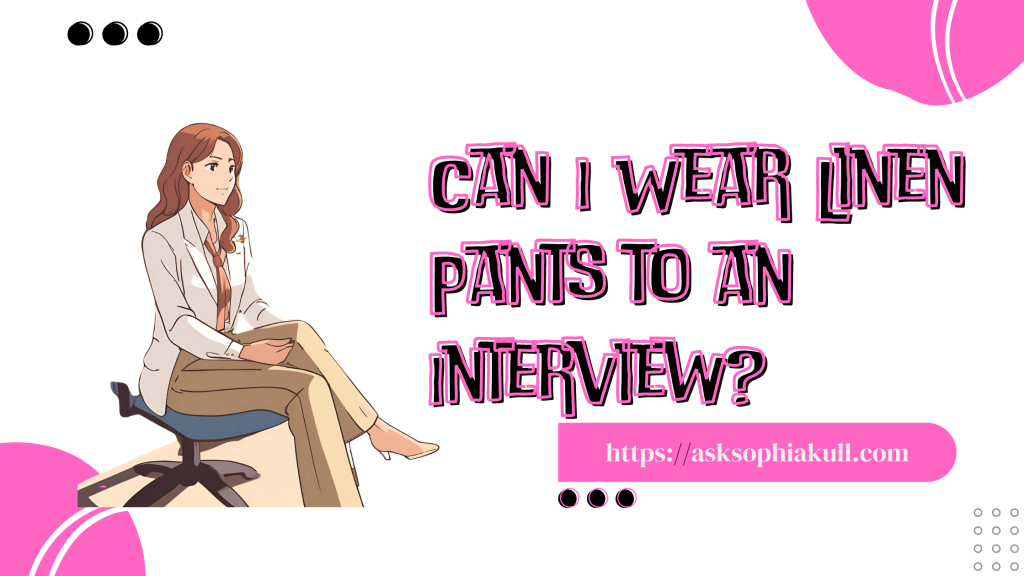
Wondering if linen pants are the right choice for an interview?
Linen is a breathable, lightweight fabric that’s great for staying cool and comfortable, but it can sometimes feel too casual.
When it comes to interviews, first impressions matter, and it’s essential to balance comfort with professionalism.
The answer depends largely on the type of job you’re interviewing for, the office dress code, and even the season.
If you’re meeting with a tech startup or creative agency where the culture leans more casual, well-tailored linen pants could work.
For traditional industries like finance or law, however, linen pants may feel too laid-back.
In this post, you will learn if you can wear linen pants to a job interview, and how style linen pants for interviews, and when to avoid linen pants completely.
Can I Wear Linen Pants To An Interview?
Ultimately, the key to making linen pants work for an interview is in how you style them.
A structured blazer, polished shoes, and neutral tones can elevate your look, adding a professional touch that balances linen’s relaxed vibe.
Read: 10 Appropriate Shoes For Business Casual Office
Here’s a breakdown on how to approach styling linen pants for interviews, tips on what to pair them with, and when they might be best left in the closet.
1. Research the Company Culture
Before deciding on an interview outfit, it’s essential to research the company culture.
Companies with a more relaxed dress code—like tech startups, creative agencies, or certain non-profits—often favor smart-casual or business-casual attire.
If your target company falls into these categories, linen pants can be a comfortable yet professional choice, especially when paired well.
However, for more traditional industries like finance, law, or corporate consulting, you’re likely better off with a tailored suit or more formal business attire.
Knowing the culture is the first step in choosing linen with confidence.
2. Choosing Tailored Linen Pants
Fit is everything when it comes to wearing linen pants to an interview.
A tailored, slim cut that isn’t too loose or overly casual will keep the outfit looking polished.
Darker shades like navy, charcoal, or black are ideal as they make linen pants feel more professional.
If you’re set on a lighter shade, keep it neutral—beige or light grey can work if they’re styled thoughtfully.
Avoid baggy or wide-legged linen pants, which can lean too casual.
The goal is to have a clean, polished look that presents you as focused and professional.
3. Pairing with a Blazer and Dress Shoes
A structured blazer is a perfect way to elevate linen pants.
Choose a blazer that complements the color of your pants but adds a touch of formality, like a classic black or navy.
This contrast makes linen pants feel interview-ready and adds the structure linen naturally lacks.
Pair this with a simple, crisp shirt in a neutral shade, and finish with polished loafers or dress shoes.
This keeps the look clean and put-together, balancing linen’s relaxed feel with elements that speak to professionalism.
Read: 7+ Best Blazer Colors To Wear With Navy Pants
When to Avoid Linen Pants?
As versatile as linen can be, there are times it’s best to leave it out of the interview lineup.
For interviews in formal or corporate settings, linen’s casual nature may not align with expectations.
In these cases, a classic suit in wool or a similar structured fabric will give you a more authoritative look.
Additionally, avoid linen pants if the forecast calls for rain; linen is notoriously prone to wrinkling and can appear crumpled in damp weather.
Being mindful of the environment and setting will help you make the best choice.
Read: Nail The Business Casual Look With These 25+ Chic Outfit Ideas
Conclusion
Linen pants can be a comfortable yet polished choice for certain interviews, especially in casual or creative fields.
The key to wearing them well is in the styling: focus on tailored cuts, darker or neutral shades, and balance linen’s relaxed feel with structured pieces.
For most business-casual environments, well-chosen linen pants can be a unique, stylish way to express professionalism.
However, when in doubt, a traditional suit is a safer option.
Choose wisely based on the company and culture, and you’ll leave a strong, confident impression.



